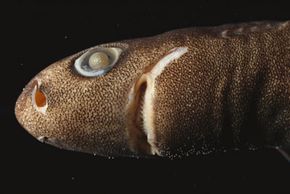In the deep waters of the Earth's oceans, size matters. Just ask the great white shark. At 20 or more feet long, it ranks as one of the largest predators in the ocean and you'd have a hard time finding a more feared fish. Bull and tiger sharks are no slouches either, growing to lengths of 10 to 15 feet, with healthy appetites. The advantage that size offers in the ocean is that the larger you are, the fewer fish there are that will have the desire and ability to try to eat you -- most fish feed on prey smaller than they are. The bull shark is an exception -- it often goes after larger prey. But the bull shark aside, chances are if you're the big fish, you'll be safe from predators.
Advertisement
The size of your standard common shark, or elasmobranch, ranges from the four-foot-long spiny dogfish shark to the 40-foot whale shark -- and there are a lot of sizes in between. At the other end of the spectrum, there's the spined pygmy shark, squaliolus laticaudus. The poor pygmy is just a little guy. They only grow to about 9 inches long (25 cm), and that's about the biggest one you'll ever find. The pygmy's average size is only 7 to 8 inches (17 to 20 cm). Not much is known about its weight, but at that length it can't be much.
You'd think that being so small would make the spined pygmy shark an endangered species. Instead, it's actually one of the few sharks that isn't threatened. The pygmy may be small, but it has a couple of tricks up its sleeve to help it avoid the jaws of larger predators. Even though the pygmy is thought to be abundant, it's rarely seen by humans because of the depths it lives in. This trait has left the pygmy as somewhat of a mystery in the shark world. And since it doesn't pose a danger to humans and it isn't fished for its tiny little fillet, researchers haven't put a lot of time into studying it.
In this article, we'll tell you what we know about this diminutive shark -- where it swims, what it eats and what it does to avoid the jaws of its larger cousins.
Advertisement

